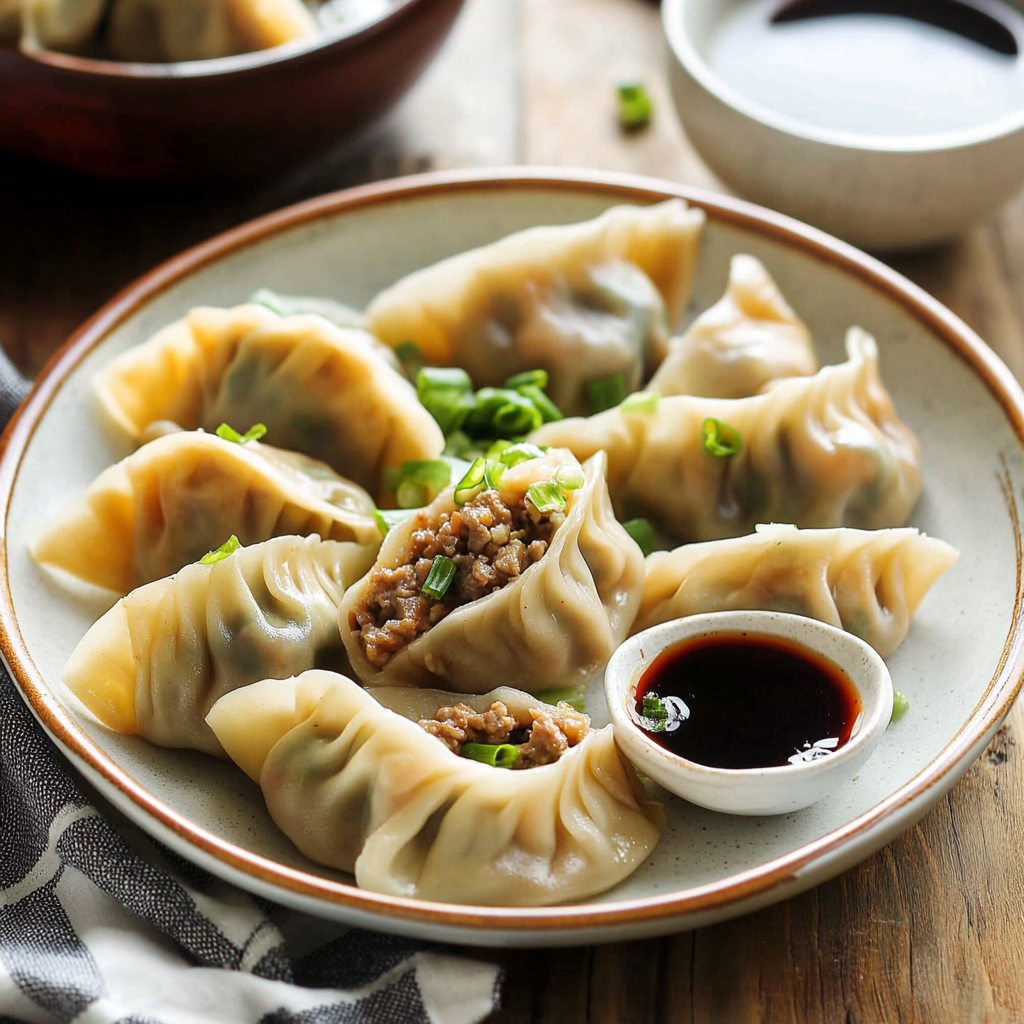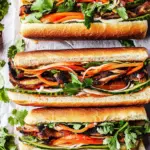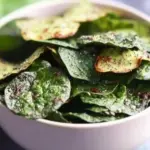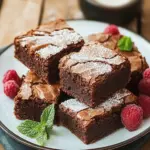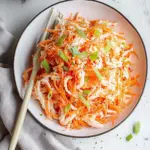The perfect balance of tender beef and crisp celery makes these Chinese dumplings an irresistible treat. Every bite is juicy, savory, and loaded with flavor thanks to ginger, garlic, soy sauce, and a splash of Shaoxing wine.
Whether you’re prepping for Lunar New Year or craving a comforting, homey dish on a weeknight, these dumplings will deliver. They’re great to make in batches, freeze well, and are always a crowd favorite. Serve with a side of black vinegar and chili oil to elevate the experience even more.
Full Recipe
Ingredients:
For the dough:
-
2 cups all-purpose flour
-
1/2 cup cold water (plus more as needed)
For the filling:
-
1 lb ground beef
-
1 1/2 cups Chinese celery, finely chopped
-
2 tablespoons soy sauce
-
1 tablespoon Shaoxing wine (or dry sherry)
-
1 tablespoon sesame oil
-
1/2 teaspoon white pepper
-
1/2 teaspoon salt
-
1 tablespoon ginger, grated
-
2 garlic cloves, minced
-
1 green onion, finely chopped
For boiling:
-
Water, for boiling dumplings
-
Optional: black vinegar and chili oil, for dipping
Directions:
-
In a large bowl, gradually mix the flour with cold water until a dough forms. Knead for about 10 minutes until smooth. Cover and let it rest for 30 minutes.
-
In a separate bowl, combine all filling ingredients: ground beef, Chinese celery, soy sauce, Shaoxing wine, sesame oil, white pepper, salt, ginger, garlic, and green onion. Mix well until fully incorporated and slightly sticky.
-
After the dough has rested, divide it into small pieces (about 1-inch diameter). Roll each piece into a thin round wrapper.
-
Spoon about 1 tablespoon of filling into the center of each wrapper. Fold and pinch the edges to seal tightly into your preferred dumpling shape.
-
Bring a large pot of water to a boil. Add dumplings in batches and cook until they float to the surface, plus an additional 2–3 minutes (about 6–8 minutes total).
-
Remove with a slotted spoon. Serve hot with black vinegar and chili oil if desired.
Prep Time: 40 minutes | Cooking Time: 10 minutes | Total Time: 50 minutes
Kcal: 230 kcal | Servings: 6 servings
Origins of Chinese Beef Dumplings with Celery
Chinese dumplings, also known as jiaozi (饺子), are a staple of Chinese cuisine with deep historical and cultural roots. These dumplings have been a beloved food in Chinese households for centuries, especially during festivals like the Lunar New Year. They symbolize wealth and prosperity due to their resemblance to ancient Chinese gold ingots. While pork is the traditional filling in most regions, beef dumplings offer a delicious alternative that’s popular in northern China, where beef is more commonly consumed. The addition of Chinese celery—a variety known for its bold, peppery flavor—brings a fresh crunch and aromatic complexity that balances the richness of the ground beef beautifully.
Beef dumplings with celery are a common dish served in family gatherings, street food stalls, and high-end Chinese restaurants alike. The flavor combination is appreciated for its hearty, savory profile enhanced by traditional seasonings such as soy sauce, sesame oil, ginger, and garlic. The wrapper, made from a simple flour-and-water dough, offers a tender yet slightly chewy texture that perfectly complements the juicy interior.
The Role of Chinese Celery
Unlike Western celery, Chinese celery is thinner, darker green, and more intensely flavored. It adds a sharp, herbaceous brightness to the dumpling filling. In traditional Chinese medicine, celery is believed to help cool the body, support digestion, and reduce inflammation. Its strong aroma and crunchy texture cut through the fattiness of the beef, making the overall bite much more balanced and refreshing.
Chinese celery isn’t just a filler—it plays a starring role in this dumpling, offering both nutritional and culinary benefits. It’s rich in fiber, vitamins A and C, and antioxidants. When finely chopped and mixed with ground beef, it softens slightly during cooking but retains just enough bite to stand out in each dumpling.
Flavor Profile and Texture
These dumplings are a masterpiece of contrast and balance. The beef brings depth and umami, while the celery adds a refreshing crunch and slight bitterness. Aromatics like ginger, garlic, and green onion give the filling a fragrant kick, and seasoning ingredients like soy sauce and sesame oil add layers of savory and nutty notes. The dumpling dough, soft and chewy when boiled, provides a neutral base that allows the filling to shine.
Dipping sauces further elevate the flavor. A common combination includes black vinegar and chili oil, which enhances the dumplings with acidity and heat, turning each bite into a vibrant, multi-dimensional experience.
Cooking Techniques: Boiled vs. Pan-Fried
One of the great things about dumplings is their versatility in cooking methods. These beef and celery dumplings are traditionally boiled, resulting in a soft, silky wrapper and a juicy, steaming interior. Boiling is also healthier than frying and keeps the dish light while retaining the full essence of the filling.
However, you can also pan-fry the dumplings to create potstickers—known as guo tie (锅贴) in Chinese. This method gives the dumplings a crispy golden base while keeping the top part soft and chewy. The contrast in textures adds another level of excitement to the dish. Both cooking methods are excellent and depend on personal preference or the occasion.
Cultural Significance and Celebratory Use
In Chinese culture, dumplings symbolize unity and are often made together with family members in a communal setting. It’s common to see multiple generations sitting around the table, filling and folding dumplings during festive occasions. The process becomes a bonding ritual as much as a cooking task. These dumplings are especially popular during Chinese New Year, symbolizing good luck and the ushering in of prosperity.
Some households even hide a coin in one of the dumplings. The person who finds it is believed to have good fortune in the coming year. While the traditional pork filling is most popular, beef dumplings are often used as a halal-friendly version for families who do not eat pork, making them an inclusive dish appreciated across various communities.
Nutritional Considerations
From a nutritional standpoint, beef dumplings with celery offer a balanced meal in a small package. The beef is a good source of protein and iron, while the celery adds fiber, vitamins, and minerals. When boiled rather than fried, the dumplings are relatively low in fat and calories.
Making your dumplings at home allows you to control the ingredients, reduce sodium, and avoid preservatives commonly found in store-bought versions. For an even healthier version, you can use lean ground beef and add additional vegetables like mushrooms, carrots, or napa cabbage to the filling.
Serving Suggestions and Pairings
These dumplings are typically served with a simple dipping sauce made from soy sauce, black vinegar, and chili oil. However, you can customize your own with additions like minced garlic, ginger slivers, or a dash of sugar for a touch of sweetness.
They pair wonderfully with light sides such as steamed bok choy, a cucumber salad with sesame dressing, or a hot bowl of egg drop soup. For drinks, green tea or jasmine tea complements the dumplings without overpowering their flavor. You can also serve them with a Chinese-style hot and sour soup for a more substantial meal.
For a dumpling party, consider offering a variety of fillings—such as chicken and mushroom or shrimp and chive—alongside the beef and celery version. This variety not only caters to different tastes but also turns the meal into an interactive and festive event.
Tips for Perfect Dumplings
-
Rest the dough: Letting the dough rest after kneading allows the gluten to relax, making it easier to roll into thin, even wrappers.
-
Mix the filling thoroughly: Stir in one direction until the beef mixture becomes sticky. This helps the filling hold together and improves its texture.
-
Don’t overfill: It can be tempting to add too much filling, but overstuffing can lead to burst dumplings during cooking.
-
Seal tightly: Make sure there are no air pockets in the dumplings. Press the edges together firmly to prevent leaking.
-
Cook in batches: Don’t overcrowd the pot when boiling. This helps them cook evenly and prevents sticking.
Why Make Dumplings from Scratch?
There’s something incredibly satisfying about making dumplings by hand. The process, while time-consuming, is therapeutic and rewarding. It allows for creativity, family bonding, and control over every ingredient. Homemade dumplings are fresher, healthier, and more flavorful than store-bought ones, with no need for artificial preservatives.
Moreover, they freeze beautifully. Simply line them up on a baking sheet, freeze until solid, and store in zip-top bags. Cook straight from frozen by boiling or pan-frying, adding just a few more minutes to the cooking time.
Conclusion
Chinese Beef Dumplings with Celery are more than just a meal—they’re a culinary experience steeped in tradition, culture, and comfort. From the aromatic beef filling infused with ginger and sesame oil to the crisp notes of Chinese celery and the tender homemade wrappers, every element contributes to a deeply satisfying dish. Whether you’re celebrating a holiday, cooking with loved ones, or simply craving something hearty and delicious, these dumplings deliver.
They’re versatile, nutritious, and bursting with bold, authentic flavors. Making them from scratch gives you a deeper appreciation of Chinese cuisine and connects you to generations of tradition. Once you master this recipe, it may just become a staple in your kitchen—a go-to dish that brings people together, one dumpling at a time.

